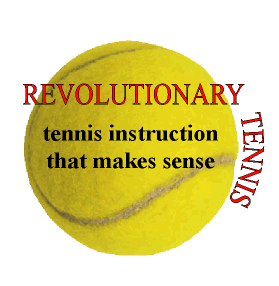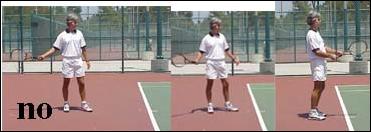Revolutionary Tennis |
||
Tennis Instruction That Makes Sense |
||
How To Apply Step 1
The Geometric Reality of Tennis The habits you most likely have that conflict with moving into the ball when it's hit to your side are: - you back up first, stop and then hit the ball, then move forward to stand toes touching the baseline, then repeat the process when your opponent hits the ball back. - you immediately turn sideways, and wait. - you simply wait. - you move parallel to the baseline because you know you'll cross paths with the ball at some point and that seems to be fine. While we may know the tennis ball won't bounce over our heads, we still want to move back when the opponent hits it. I have a feeling it's a primordial reflex to flinch backwards when an object heads in our direction, having something to do with establishing whether the object is friend or foe. I see this reflex in children, and of course in adults. I've got news for you. The tennis ball is your friend. This habit of instinctively moving back has to be trained out of a tennis player. How? First, you understand the simple, single direction of moving forward when the opponent hits the ball and its enormous payoff. And then do it! A lot of forward movement is not required, just that you not back up when it's your turn to hit the ball. You get to back up (to where you started from) only after you hit the ball.
Start 3 to 5 Feet Back Behind The Baseline
Why are your toes touching the baseline when you're in the ready position? So you don't have to move too much to hit the ball? So you can hit the ball and not have to move too much after that to get "ready"? Well, you've got it back asswards.
Start 3 to 5 feet Back Behind The Baseline Phew |
||
|
|
||||||||||||||||||||||||||||||||||||||||||||||||||||||||||||||



 Start 3 to 5 feet back behind the baseline, then go forward. Then get back to where you were so you can have enough room and time to handle the next ball (by moving into it). Are you afraid or too lazy to do this? It's called exercise, tennis' main benefit. If you don't want to get any exercise, play golf, you won't have to move.
Start 3 to 5 feet back behind the baseline, then go forward. Then get back to where you were so you can have enough room and time to handle the next ball (by moving into it). Are you afraid or too lazy to do this? It's called exercise, tennis' main benefit. If you don't want to get any exercise, play golf, you won't have to move. Start 3 to 5 feet back behind the baseline, move forward, move back to get ready, move forward. You don't have to do this 100% to play better, just some of it most of the time. Are you satisfied with your power now? If you are, okay, keep doing your thing. But if you want a little more, or you want things a little better...
Start 3 to 5 feet back behind the baseline, move forward, move back to get ready, move forward. You don't have to do this 100% to play better, just some of it most of the time. Are you satisfied with your power now? If you are, okay, keep doing your thing. But if you want a little more, or you want things a little better...